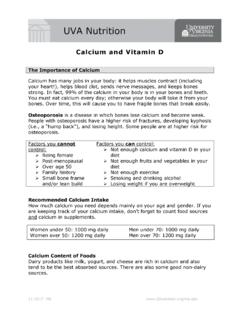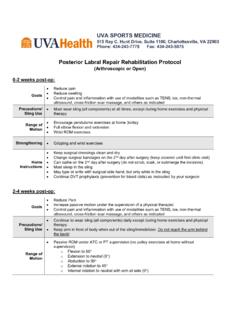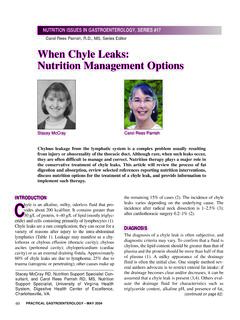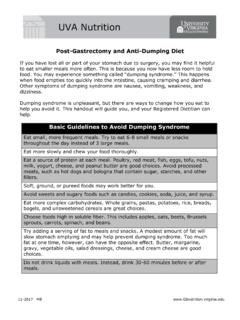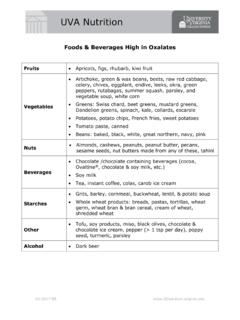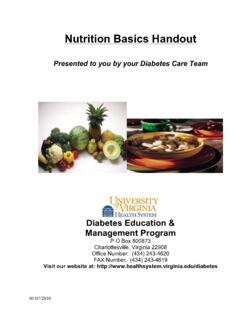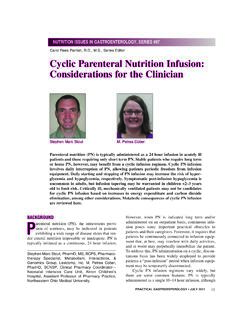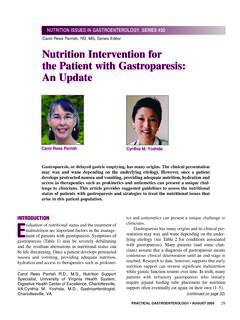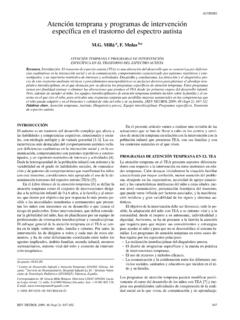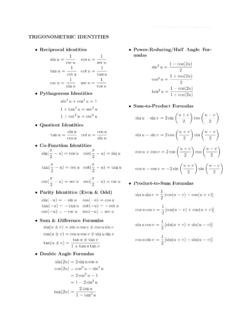Transcription of Carol Rees Parrish, R.D., MS, Series Editor Enteral ...
1 PRACTICAL GASTROENTEROLOGY JUNE 200544 INTRODUCTIONIn the last 25 years the number and variety of enteralformulas that are available for use has increased dra-matically. Well over 100 Enteral formulas are nowavailable, making formula selection rather addition, Enteral formulas are considered food sup-plements by the Food and Drug Administration (FDA)and are therefore not under the same regulatory controlas medications. As a result, Enteral formula labels maymake structure and function claims without priorFDA review or approval. Furthermore, there is a lackof prospective, randomized, controlled clinical trialssupporting the purported indications for the majority ofthe specialized formulas currently on the market. Enteral formulas may be classified as standard,elemental or specialized. Many formulas are availablewithin each category, often containing significant dif-ferences in nutrient composition. Standard Enteral for-mulas are defined as ones with intact protein contain-ing balanced amounts of macronutrients and will oftenmeet a patient s nutrient requirements at significantlyless cost than specialized formulas (See Table 1 forEnteral Formula Selection: A Review of Selected Product CategoriesNUTRITION ISSUES IN GASTROENTEROLOGY, Series #28 Carol Rees Parrish, , MS, Series EditorAinsley M.)
2 Malone, MS, RD, LD, CNSD, Mt. CarmelWest Hospital, Department of Pharmacy, Columbus, availability of specialized Enteral formulas has burgeoned in the last 20 years,many touting pharmacologic effects in addition to standard nutrient delivery. Enteralformulas have been developed for many specific conditions including: renal failure,gastrointestinal (GI) disease, hyperglycemia/diabetes, liver failure, acute and chronicpulmonary disease and immunocompromised states. Elemental and fiber supple-mented formulas are also frequently recommended for use in those with certain typesof gastrointestinal dysfunction. This article will review the rationale for use of special-ized formulas, provide the supportive evidence, if available, and provide suggestions forclinical application. Ainsley Malone(continued on page 46) PRACTICAL GASTROENTEROLOGY JUNE 200546 Enteral Formula SelectionNUTRITION ISSUES IN GASTROENTEROLOGY, Series #28commonly used products).
3 Specialized formulas aredesigned for a variety of clinical conditions or diseasestates. There are over thirty-five specialized formulascurrently on the market. The purpose of this article isto review the rationale behind specialized formulas,provide supportive evidence, if available, and to fur-nish suggestions for clinical application. Enteral for-mulas for common food allergies as well as homemadeblenderized formulas are also discussed. Elementaland immune-modulated formulas will be reviewed infuture issues of Practical Gastroenterology. STANDARD FORMULASS tandard formulas comprise the Enteral product cate-gory most often used in patients requiring tube feed-ings. Their nutrient composition is meant to match thatrecommended for healthy individuals. Table 2 pro-vides a comparison of nutrient sources in polymericand hydrolyzed products. Calorie Dense ProductsNutrient concentrations of standard formulas varyfrom kcal/mL and products may or may notcontain fiber.
4 These formulas may be used with vol-ume sensitive patients or patients needing fluid restric-tion. Such conditions may include congestive heartfailure, renal failure or syndrome of inappropriatediuretic hormone (SIADH). However, this interventionmay not always be clinically significant (Table 3). Forexample, if a patient requires 1800 kcal/day, changinga calorie/mL to a product wouldreduce the water content by 900 mL, but to change apatient from a to a kcal/mL product representsa mere 300 mL difference per 24 hour period. Calori-cally dense formulas are most practical for use inpatients requiring nocturnal and/or bolus feeding. FIBER SUPPLEMENTED FORMULASP roposed Rationale for UseDietary fiber is defined as a structural and storagepolysaccharide found in plants that are not digested inthe human gut (1). Sources of fiber in Enteral formulasinclude soluble and insoluble (1). A recent fiber addi-tion to selected formulas (Ross products) is fruc-tooligosaccharides (FOS).
5 FOS are defined as short-chain oligosaccharides and, similar to other dietaryfibers, are rapidly fermented by the colonic bacteria toshort-chain fatty acids (SCFA). SCFA influence gas-trointestinal function through several provide an energy source for colonocytes,increase intestinal mucosal growth and promote waterand sodium absorption (2). Table 4 provides a listingof Enteral formulas and their fiber content. Fiber can be classified by its solubility in fibers, such as pectin and guar, are fermentedby colonic bacteria providing fuel for the colonocyte,as described above (1). In addition, increased colonicsodium and water absorption have been demonstratedwith soluble fiber, a potential benefit in the treatmentof diarrhea associated with EN (2). Insoluble fiber,such as soy polysaccharide, increases fecal weight,thereby increasing peristalsis and decreasing fecaltransit time (1).(continued from page 44)Table 1 Cost Comparison of Commonly Used Standard FormulasCost/ Enteral Formula1000 Kcals ($)* cal/mLFibersource cal/mLIsosource cal/mLDeliver *Based on 1-800 Company Home Delivery Numbers (see Table 17)(continued on page 48)PRACTICAL GASTROENTEROLOGY JUNE 200548 Enteral Formula SelectionNUTRITION ISSUES IN GASTROENTEROLOGY, Series #28 Historically, soluble fiber has been difficult to addto Enteral formulas due to its viscous nature.
6 Manyearly fiber supplemented Enteral formulas, therefore,contained soy polysaccharide as their primary fibersource. Subsequent technological advances haveenabled the inclusion of soluble fiber sources to enteralformulas and many now contain a combination of bothsoluble and insoluble fibers. Supporting EvidenceResearch evaluating fiber-containing Enteral formulasin the management of diarrhea has demonstrated incon-sistent results (3 4). This may be related more to thetype of fiber provided rather than the overall fiberintake. In a small crossover study, Frankenfield andBeyer compared insoluble fiber with a fiber free for-mula in nine head injured enterally fed patients andfound no significant difference in diarrhea incidence(5). Khalil, et al compared a fiber free formula with aformula providing insoluble fiber on diarrhea incidencein surgery patients (6). No significant differences instool frequency or stool consistency were demonstratedbetween groups.
7 Conversely, Shankardass, et al com-pared long-term enterally fed patients receiving a for-(continued from page 46)(continued on page 50)Table 2 Macronutrient Sources in Enteral Formulas Enteral Formula CarbohydrateProteinFatPolymeric Corn syrup solidsCaseinBorage oilHydrolyzed cornstarchSodium, calcium, magnesium and Canola oilMaltodextrinpotassium caseinatesCorn oilSucroseSoy protein isolateFish oilFructoseWhey protein concentrateHigh oleic sunflower oilSugar alcoholsLactalbuminMedium chain triglyceridesMilk protein concentrateMenhaden oilMono- and diglyceridesPalm kernel oilSafflower oilSoybean oilSoy lecithinHydrolyzed CornstarchHydrolyzed caseinFatty acid estersHydrolyzed cornstarchHydrolyzed whey proteinFish oilMaltodextrinCrystalline L-amino acidsMedium chain triglyceridesFructoseHydrolyzed lactalbuminSafflower oilSoy protein isolateSardine oilSoybean oilSoy lecithinStructured lipidsTable 3 Water Content of Various Enteral Formula DensitiesCaloric Density % WaterVolume /1800 kcal (mL)Water by density for 1800 Kcal (mL)
8 Kcal/mL70900630 PRACTICAL GASTROENTEROLOGY JUNE 200550 Enteral Formula SelectionNUTRITION ISSUES IN GASTROENTEROLOGY, Series #28(continued from page 48)Table 4 Fiber Content of Selected Enteral FormulasTotal Dietary % % Cost / ProductFiber (g/L)Insoluble Fiber Soluble Fiber 1000 Kcal ($)* **NovartisFibersource **NovartisPeptamen XL **NovartisReplete Plus *Based on 1-800 Company Home Delivery Numbers (see Table 17); ** McKesson (800/446-6380)mula containing insoluble fiber with those on a fiber-free formula. Fecal weight and number of stools perday were not significantly different between the groupsbut the incidence of diarrhea was significantly greaterin the group receiving the fiber-free formula (7). Insol-uble fiber has not been clearly shown to improve diar-rhea, especially in the acutely ill patient (3). Solublefiber has been associated with more promising an evaluation of septic, critically ill patients in amedical intensive care unit (ICU), Spapen, et al com-pared a soluble fiber with a fiber-free Enteral of diarrhea was significantly decreased inthose receiving the fiber-supplemented formula (8).
9 Inaddition, a recent evaluation of patients in a medicalintensive care unit receiving a soluble-fiber containingformula (N = 20), demonstrated a decrease in diarrhealepisodes with the fiber-supplemented formula com-pared to a fiber-free formula (9). Use in the Clinical SettingEnteral formulas supplemented with soluble fiber arecloser to a normal diet; however, evidence for their useremains weak. Several cases of bowel obstructionassociated with the use of insoluble fiber-containingformulas have been reported in the surgical and burnpopulation (10,11). Until further evidence is available,a fiber-free Enteral formula in patients who requiremotility suppressing medications and/or are at risk forbowel obstruction or ischemia may be prudent. In arecent review of Enteral nutrition in the hypotensivepatient, McClave and Chang, 2004, recommend theuse of a fiber-free formula in critically ill patients athigh risk for bowel ischemia (12).
10 DISEASE SPECIFIC FORMULASR enal DiseaseProposed Rationale For UseFormulas designed for patients with renal disease varyin protein, electrolyte, vitamin and mineral content(Table 5). Generally, renal formulas are lower in pro-(continued on page 52)(continued from page 50)PRACTICAL GASTROENTEROLOGY JUNE 200552tein, calorically dense and have lower levels of potas-sium, magnesium and phosphorus when compared tostandard formulas. Supporting EvidenceThere are no clinical trials comparing the efficacy ofrenal formulas against standard products. Use in the Clinical SettingFormula selection depends upon a patient s degree ofrenal function, the presence or absence of renalreplacement therapy, and the patient s overall nutrientrequirements. Patients undergoing renal replacementtherapy have significantly increased protein require-ments that may not be met with the current renal for-mulas available. Persistent hyperkalemia, hyperman-ganesemia, hyperphosphatemia is often the drivingfactor that leads most clinicians to switch from a stan-dard formula to a renal product.

